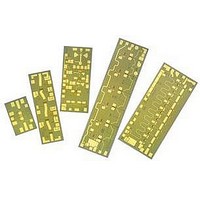AMMC-3041-W10 Avago Technologies US Inc., AMMC-3041-W10 Datasheet - Page 4

AMMC-3041-W10
Manufacturer Part Number
AMMC-3041-W10
Description
IC MIXER DBL BALL 18-42GHZ
Manufacturer
Avago Technologies US Inc.
Series
AMMC-3041r
Datasheet
1.AMMC-3041-W10.pdf
(5 pages)
Specifications of AMMC-3041-W10
Function
Mixer
Frequency Max
42GHz
Frequency Min
18GHz
Lead Free Status / RoHS Status
Lead free / RoHS Compliant
Lead Free Status / RoHS Status
Lead free / RoHS Compliant, Lead free / RoHS Compliant
Available stocks
Company
Part Number
Manufacturer
Quantity
Price
Part Number:
AMMC-3041-W10
Manufacturer:
AVAGO/安华高
Quantity:
20 000
4
Applications Information
Operation of the AMMC- 3041 is very straightforward.
The RF, LO, and IF ports can be connected directly to
50 Ω circuits. None of the three ports should have a
DC voltage applied to them. If DC voltages are present,
a blocking capacitor should be used.
Some enhancement in Conversion Loss may be
obtained by reflectively terminating the LO and RF
signals at the IF port. This is easily done by connecting
a 20- mil long bond wire from the IF output pad on
the MMIC to a shunt, off-chip 0.5 pF chip capacitor as
indicated in Figure 7.
For up conversion applications, the input signal is nor-
mally applied to the IF port, the local oscillator
connected to the LO port, and the up-converted
output signal taken from the RF port.
Assembly Techniques
The backside of the AMMC- 3041 chip is RF ground. For
microstripline applications, the chip should be attached
directly to the ground plane (e.g., circuit carrier) using
electrically conductive epoxy
For best performance, the topside of the MMIC should
be brought up to the same height as the circuit sur-
rounding it. This can be accomplished by mounting a
gold plated metal shim (same length and width as the
MMIC) under the chip, which is of the correct thickness
to make the chip and adjacent circuit coplanar.
The amount of epoxy used for chip and or shim attach-
ment should be just enough to provide a thin fillet
around the bottom perimeter of the chip or shim. The
ground plane should be free of any residue that may
jeopardize electrical or mechanical attachment.
For use on coplanar circuits, the chip can be mounted
directly on the topside ground plane of the circuit.
[1]
.
The location of the RF, LO, and IF bond pads is shown in
Figure 8. Note that all I/O ports are in a Ground-Signal-
Ground configuration. The IF port is located near the
middle of the die, which allows this connection to be
made from either side of the chip for maximum layout
flexibility.
RF connections should be kept as short as reasonable
to minimize performance degradation due to series in-
ductance. A single bond wire is sufficient for all signal
connections. However, doublebonding with 0.7 mil gold
wire or the use of gold mesh
performance, especially near the high end of the fre-
quency range.
Thermosonic wedge bonding is the preferred method
for wire attachment to the bond pads. Gold mesh can
be attached using a 2 mil round tracking tool and a tool
force of approximately 22 grams with an ultrasonic
power of roughly 55 dB for a duration of 76 ± 8 mS.
A guided wedge at an ultrasonic power level of 64 dB
can be used for the 0.7 mil wire. The recommended
wire bond stage temperature is 150 ± 2°C.
Caution should be taken to not exceed the Absolute
Maximum Rating for assembly temperature and time.
The chip is 100 µm thick and should be handled with
care. This MMIC has exposed air bridges on the top
surface and should be handled by the edges or with a
custom collet (do not pick up die with vacuum on die
center.)
This MMIC is also static sensitive and ESD handling pre-
cautions should be taken.
Notes:
1. Ablebond 84-1 LM1 silver epoxy is recommended.
2. Buckbee-Mears Corporation, St. Paul, MN, 800-262-3824.
[2]
is recommended for best


















